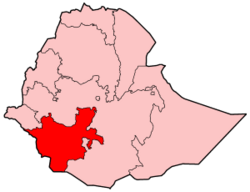Southern Nations, Nationalities, and People's Region
| ደቡብ ብሔሮች ብሔረሰቦችና ሕዝቦች ክልል | the Southern Nations, Nationalities, and People's Region | ||
|
|||
 |
|||
| Map of Ethiopia highlighting the Southern Nations, Nationalities and People's region | |||
| Capital city | Awasa | ||
| Official languages | Amharic | ||
| Recognised regional languages\Dialects | See this list | ||
Southern Nations, Nationalities, and People's Region (often abbreviated as SNNPR) is one of the nine ethnic divisions (kililoch) of Ethiopia. It comprises the former Regions 7-11. Its capital is Awasa.
The SNNPR borders Kenya to the south, the Ilemi Triangle (a region claimed by Ethiopia, Kenya, and Sudan) to the southwest, Sudan to the west, the Ethiopian region of Gambela to the north, and the Ethiopian region of Oromia to the north and east. Besides Awasa, the region's major cities and towns include Arba Minch, Bonga, Chencha, Dila, Irgalem, Mizan Teferi, Sodo, Wendo, and Worabe.
Contents |
Demographics
Based on figures from the Central Statistical Agency of Ethiopia (CSA) published in 2005, the SNNPR has an estimated total population of 14,901,990, consisting of 7,408,993 men and 7,492,997 women. 13,625,000 or 91.4% of the population are estimated to be rural inhabitants, while 1,277,000 or 8.57% are urban; this makes the SNNPR Ethiopia's most rural region. With an estimated area of 112,343.19 square kilometers, this region has an estimated density of 132.65 people per square kilometer. [1]
These estimates are based on the 1994 census, in which the region's total population was reported to be 10,377,028 of which 5,161,787 were males and 5,215,241 were females. At the time of the census, the rural population of the Region accounted for 93.2% of the total population. Semien Omo, Sidama, and Gurage were the three zones with the highest population. The population is concentrated mostly in eastern, northern and central part of the SNNPR while the western and southern part of the Region is sparsely populated.
According to the 1994 census 34.8% of inhabitants were Protestants, 27.6% Orthodox Christians, 16.7% Muslims, 15.4% followers of traditional religions and 3,0% Roman Catholics.
The SNNPR Water Resources Bureau announced that as of the fiscal year ending in 2006, they had increased the area of the Region that had access to potable water to 54% from 10-15% 15 years ago. 60 million Birr has been allocated for the next fiscal year to bring coverage to an additional 34 woredas and 21 towns, increasing coverage to 59% of the population.[2]
Ethnicities
The SNNPR, being an amalgam of the main homelands of numerous ethnicities, contains over 45 indigenous ethnic groups. The 1994 census reported that the predominantly spoken languages include Sidamigna (18%), Guragigna (14.72%), Welayta (11.53%), Hadiyigna (8.53%), Keffigna (5.22%), and Kembatigna (4.35%). Other languages spoken in the State include Gamoigna, Mello, Goffa, and Gedeo; because of the relatively few number of speakers of most of the languages in the region, the working language of the state is Amharic (the most widely spoken language in Ethiopia and formerly the only official language).[3]
The ethnicities in the SNNPR include:
|
|
|
|
Agriculture
The CSA reported that for 2004-2005 100,338 tons of coffee were produced in the SNNPR, based on inspection records from the Ethiopian Coffee and Tea authority. This represents 44.2% of the total production in Ethiopia. Farmers in the Region had an estimated total 7,938,490 head of cattle (representing 20.5% of Ethiopia's total cattle), 3,270,200 sheep (18.8%), 2,289,970 goats (17.6%), 298,720 horses 19.7%), 63,460 mules (43.1%), 278,440 asses (11.1%), 6,586,140 poultry of all species (21.3%), and 726,960 beehives (16.7%).[4]
Presidents of the Executive Committee
- Abate Kisho (SEPDM) 1992 - 2001
- Vacant? 2001
- Haile Mariam Desalegne 12 November 2001 - March 2006
- Shiferaw Shigute (SEPDM) March 2006 - present
(This list is based on information from Worldstatesmen.org.)
Subdivisions
Note: This list is based on information from the latest population estimates of the CSA; however, the list of second administrative level bodies maintained by the United Nations Geographic Information Working Group divides some of these Zones and recognizes some of the woredas as not belonging to any Zone -- what is known as a "special woreda".[5]
Zones
- Bench Maji Zone
- Debub (South) Omo Zone
- Gedeo Zone
- Gurage Zone
- Hadiya Zone
- Keficho Shekicho Zone
- Kembata Alaba and Tembaro (KAT) Zone
- Semien (North) Omo Zone
- Sidama Zone
Woredas
Notes
- ↑ CSA 2005 National Statistics, Table B.3.
- ↑ Potable water expansion works underway with over 60mln birr in SNNP State Walta Information Center (last accessed 30 November 2006)
- ↑ FDRE States: Basic Information: The State of Southern Nations, Nationalities and Peoples' (last accessed 10 May 2006)
- ↑ CSA 2005 National Statistics, Tables D.2 and D.3 - D.5.
- ↑ Names and codes for January 2000, Ethiopia (WHO website). The information in the WHO spreadsheet is built on information received 18 September 2002 from the Ethiopian Ministry of Federal Affairs.
External links
- Map of Southern Nations, Nationalities, and Peoples' Region at UN-OCHA (PDF file)
- Map of Southern Nations, Nationalities and Peoples' Region at DPPA of Ethiopia (PDF file)
See also
- Southern Ethiopia Peoples' Democratic Coalition
|
|||||||||||
